 Monograms on Byzantine pentanummia
Monograms on Byzantine pentanummia
The coin to the right is a small (15 mm) pentanummium (5-nummus) piece of Phocas, Byzantine emperor AD 602-610. Unlike most Byzantine coins, the obverse does not have a portrait of the emperor, rather a monogram, ΦωKA, for the emperor's name in Greek. The reverse has the numeral Є --the Greek "5"--for the denomination. (This monogram is discussed further below.)
What's new? 2025, May 30: Another nummis. A pentanummion of Anastasius.
2024, August 7: Byzantine nummia with monograms. A pentanummion of Maurice from Carthage.
2024, April 28: An unlisted monogram for Maurice.
2024, March 19: Sear 371 and 375 from Nicomedia and Cyzicus.
2023, Nov. 15: Sear 542 of Maurice added.
2023, June 27. Some better examples. Diameters and weights added.
2022, Dec. 22. Reference works listed.
Monograms as designs on Roman coins began under Theodosius II (402-450), more than half a century before the pentanummium became a denomination introduced under the Byzantine emperor Anastasius (491-518).
 Theodosius II, 402-450.
Theodosius II, 402-450.
12.4 mm. 1.21 grams. Not a pentanummium.
The obverse legend spells out his name and the reverse has a monogram for his name, with "CON" below for the mint, Constantinople.
RIC X 463 "455-450"
Sear V 21237.
Some of the letters of
THEODOSIVS are visible in the monogram which includes
THEOΔO
Monogram reverse designs with part or all of the emperor's name continued for the later emperors in the 5th century.
Introduction of the pentanummiun. In 498 the emperor Anastasius reformed the copper coinage. The main denomination became the follis, a 40-nummus piece (with "M", Greek for "40"). Alongside it, fractions of 20 (with "K"), and 10 (with "I"). A second reform in 512 doubled the weights of the coins and introduced a 5-nummia piece with "Є" for the denomiation "5" in Greek on the reverse. The early issues of pentanummia had, on the obverse, the emperor's portrait in profile and his name in the legend, without a monogram. The denomination continued to be issued through Constantine IV (668-685). After that the only listed pentanummium is an unconfirmed type for Leo III (717-741).
Sear 29
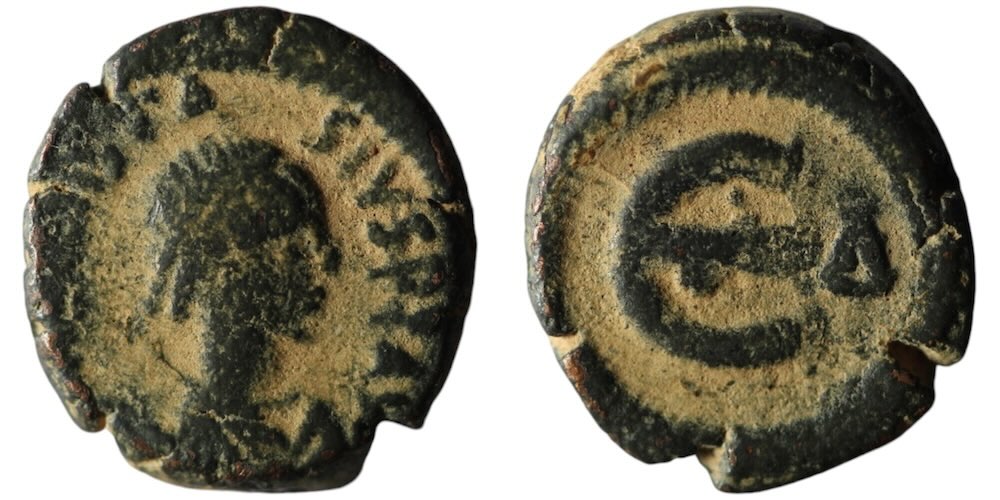 Anastasius, 491-518
Anastasius, 491-518
13.5-12.5 mm. 2.12 grams.
...ASTA-SIVS PF AVG
Є with Δ to right.
Attributed to Constantinople.
MIBE Anastasius 37, page 89, plate 3.
Under Justinian they are common and larger and sometimes much larger.
Sear 170
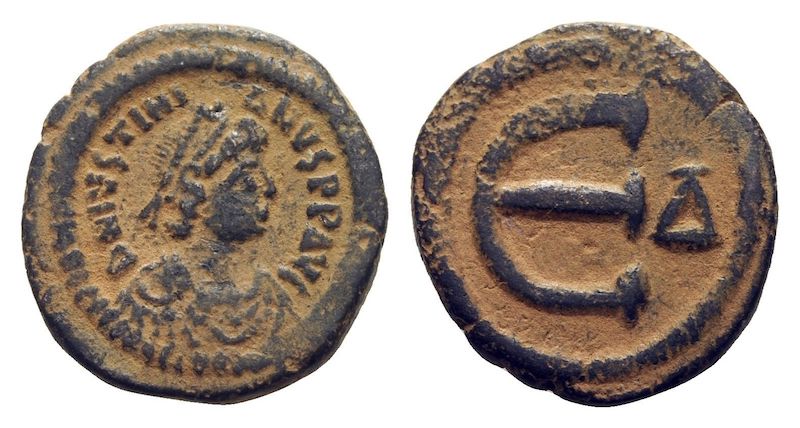
Justinian, 527-564
DN IVSTINIANVS PP AVG
19 mm. 4.42 grams. Remarkably large for the denomination.
Large Є, with officina number Δ to the right.
This one is attributed to Constantinople, but very similar types are attributed to Antioch.
Sear 170
Pentanummia with monograms. Pentanummia with monograms begin at Antioch near the end of the reign of Justinian.
Sear 245
 Justin II, 565-578, or Justinian, 527-565.
Justin II, 565-578, or Justinian, 527-565.
15 mm. 1.39 grams.
The obverse legend is badly blundered, perhaps because of the catastrophes at Antioch (The tragic story of Antioch under Justinian is here.) His 40-nummia coins of years 35-39 at Antioch have badly blundered obverse legends that look a lot like this legend, so that supports the inference that this coin is of Justinian. The legend is not clear enough to distinguish Justinian from Justin II. It might be Justin II because the legend is short (even if none of the letters are right) and because of the use of a monogram. Justin II used a monogram on the next type.
Sear 245 and MIBE for Justinian 163 (or Sear 384 and MIBEC 64 for Justin II, which I doubt). Antioch mint. Monogram 10.
The large C serves as the curved part of Є, while the central monogram is around the four ends of a cross shape of which the horizontal serves as the central horizontal of the Є. The letters include
N, A, O, T, V (?), K (?, on its side?), C (square, bottom projection longer than the top).
Is it a monogram for the mint, Antioch? ANTIO. Or, for Justin? IVCTIN .
The monogram/denomination format. Many pentanummia do not have the portrait/monogram format, rather a monogram/denomination format.
Notes: Є is the Greek numeral for 5. u is a variant of V for the Roman numeral for 5. ɣ is OV. C is a lunate S.
Sear 371
 Justin II and Sophia, 565-578
Justin II and Sophia, 565-578
15-13 mm. 1.92 grams.
Monogram 9 in Sear. The Є has an "N" to its right, for Nicomedia.
Sear 371.
The monogram has the letters of "Justin and Sophia", that is IOVCTIN OV KAI COΦIAC [Grierson, p. 61]
The symbol at the upper left, ɣ, is OV.
The S is our "Justin" is C which is in square form on the right (not evenly done, the lower leg is shorter than the T leg).
Actually, few Greek letters cannot be found somewhere in that monogram. The missing ones seem to be
Δ, E, H, Θ, Π, Ξ, Ζ, Χ, Ψ, Ω, Μ
and the ones certainly there are
Α, ɣ, Φ, Κ, Τ, Ν.
Some letters may or may not be there. For example, the left vertical stroke of "N" might serve as "I", or might not. Similarly, when "C" (sigma, our "S") is drawn in square form it might be composed of parts of "T" and "L".
Sear 375
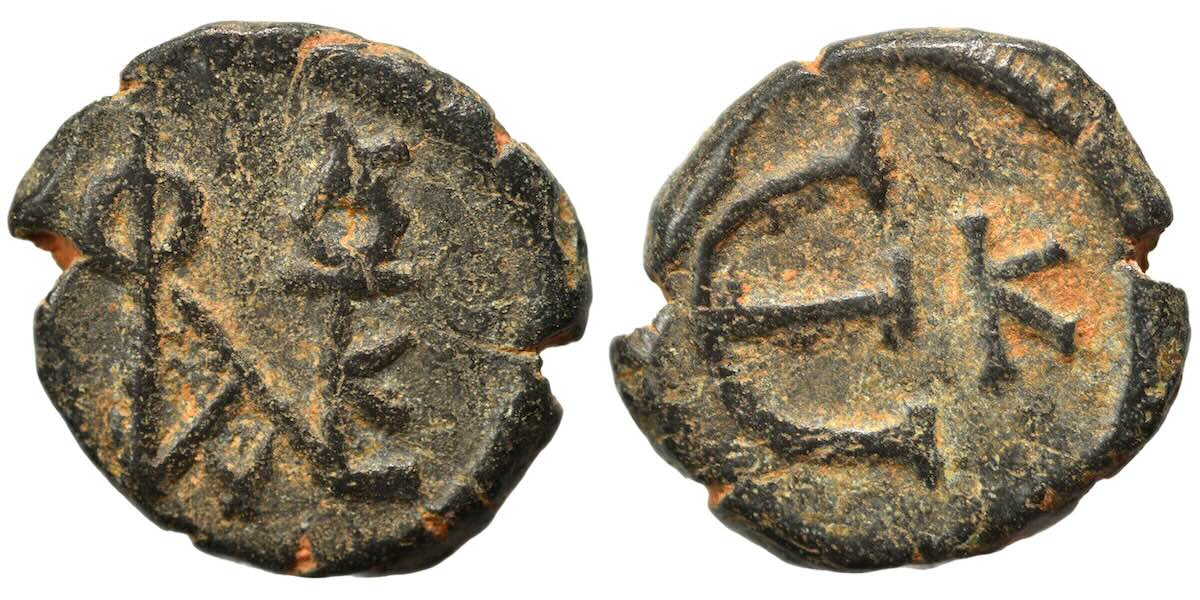 Justin II and Sophia, 565-578
Justin II and Sophia, 565-578
14 mm. 1.85 grams.
Again monogram 9 but the Є has an "K" to its right, for Kyzicos = Cyzicus.
Sear 375
Sear 386
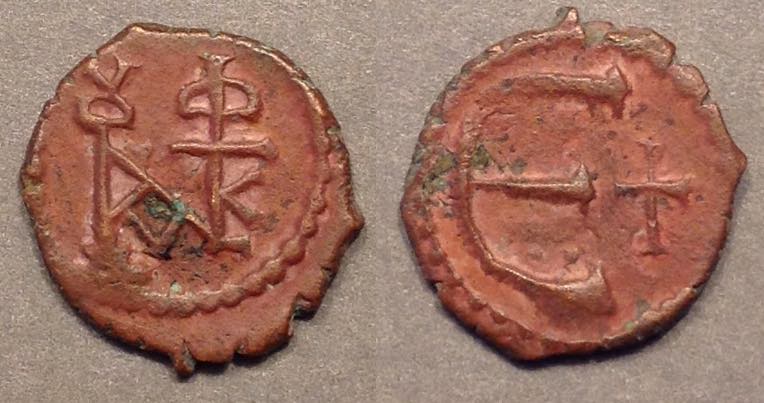 Justin II and Sophia, 565-578.
Justin II and Sophia, 565-578.
14 mm. 1.36 grams.
Є+ reverse.
Again monogram 9, but this type with the cross is attributed to Antioch.
Sear 386. Antioch mint.
Sear 386
Justin II
15-14 mm. 1.41 grams.
A second example with different dies.
Again, monogram 9 in Sear.
Sear 386. Antioch mint.
Sear unlisted. I assign it 385A.
 Justin II and Sophia, 565-578
Justin II and Sophia, 565-578
14.7-14.2 mm. 1.34 grams.
This example is slightly, but significantly, different. The positions of the ɣ and Φ are switched, making this very similar to monogram 8, except the monogram's right vertical stroke has Є on it, not K. Grierson expanded the previous type with "KAI" for "and". This one could use "ЄT". That word for "and" is explicitly used on coins of Justin and Sophia from Carthage (SB395).
Not in Sear. As Sear 385 except for the Є in the monogram. This one could be numbered 385A. Antioch mint.
Cruciform monograms. Some monograms are "cruciform" with a basic square-cross shape and letters hung on the ends of the cross.
Sear 402
J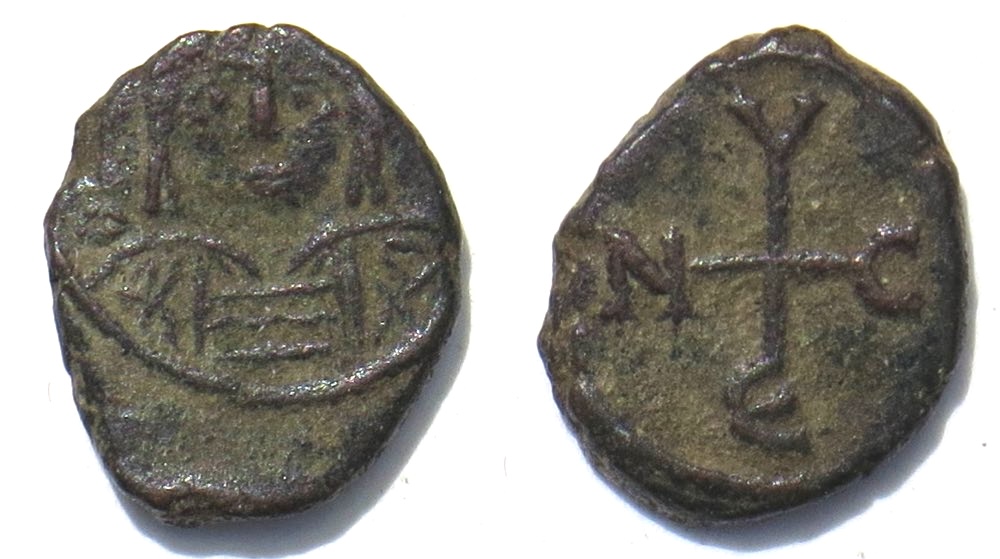 ustin II, 565-578
ustin II, 565-578
15.7-12.7 mm.
Facing bust
Cross with N left, Y above, C right, and Є below.
The Є is for "5", and the rest has the letters of
IVSTINVS where the "C" is a lunate "S" and the cross creates both the "I" and the "T".
Sear 402. Carthage. Monogram 11.
Sear 459
 Tiberius II, 582-602. Tiberius Constantine.
Tiberius II, 582-602. Tiberius Constantine.
14 mm. 1.73 grams.
This is a difficult one to attribute. The expansion of the monogram is not obvious.
The clear "N" does not belong in "Tiberius" but our modern choice to emphasize "Tiberius" from the name "Tiberius Constantine" was apparently not his choice on this coin.
The monogram seems to have
N, T, A, ɣ. square C (a lunate S), and K. Of course, "I" could be in there, too.
Grierson [p. 68] says this is for
KONSTANTOU
Maybe it also includes "TI" from "Tiberius".
Monogram 18 in Sear. Sear 459. Antioch mint.
Sear unlisted. I assign it 459A.
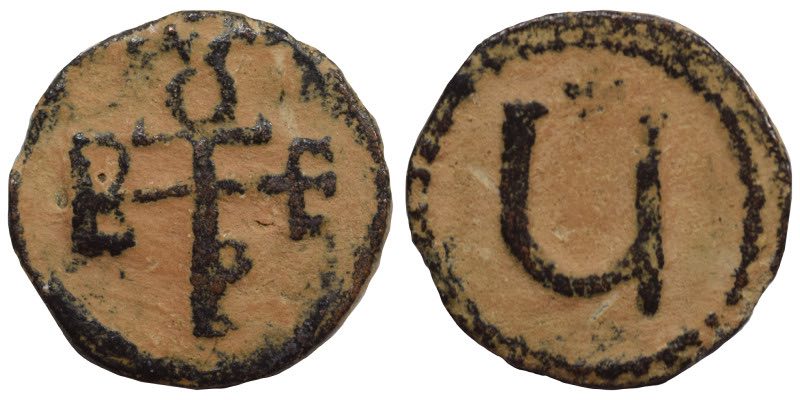 Tiberius II, 582-602
Tiberius II, 582-602
14 mm. 1.12 grams.
This monogram, in contast to the one above, emphasizes "Tiberius".
Letters are clearly
ɣ, T, B, E, P, and possibly I, so we can decipher it as
TIBEPIOV (with no S, although, stretching, the E could be regarded as containing a lunate C for our S).
This has monogram 42 in Sear, but in Sear it is only in the field on coins of Tiberius III (698-705) at Syracuse--much later than this coin of Tiberius II.
Not in Sear. Sear 459 (above) is the only pentanummium listed for Antioch, so this could be assigned number 459A. Antioch mint.
Sear 539.
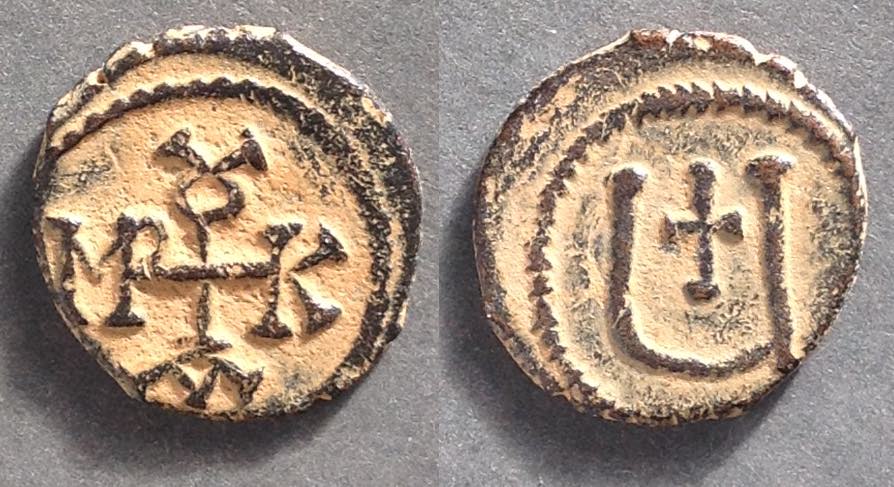 Maurice, 582-602, Maurice Tiberius
Maurice, 582-602, Maurice Tiberius
14 mm. 1.48 grams.
The monogram includes the letters
ɣ, M, P, A, K and possibly I.
MAVPIKIOU for Maurice [Grierson p. 68]
(Many of his non-monogram coins have
MAVRIC spelled in the legend)
Monogram 15 in Sear.
Sear 539. Antioch mint.
Sear 500v.
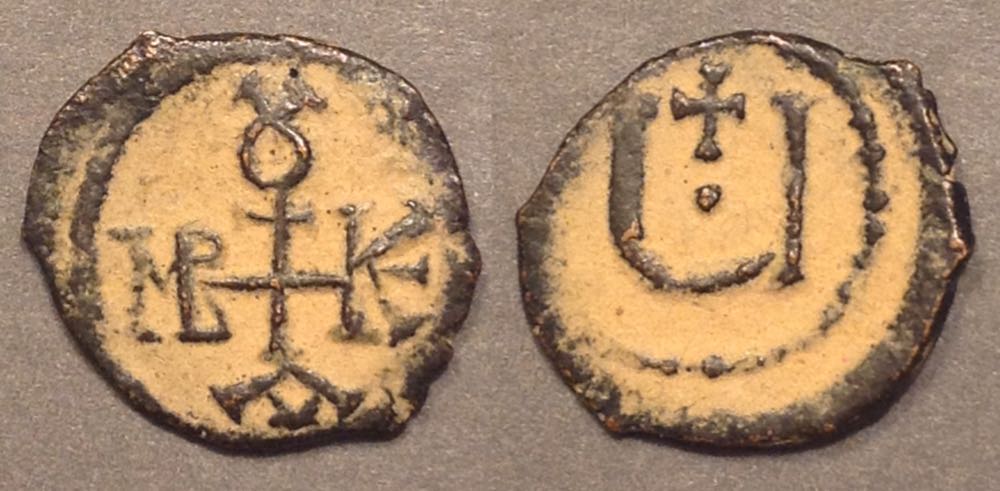 Maurice, 582-602. Maurice Tiberius
Maurice, 582-602. Maurice Tiberius
14.7-13.1 mm. 1.23 grams.
This monogram includes all the letters of the above monogram plus this one also has
T, I, B, Є, (in Tiberius)
ɣ, M, P, A, K and possibly I.
MAVPIKIOU for Maurice [Grierson p. 68]
Very close to monogram 16 in Sear, except monogram 16 has the A crossed like a T.
A variety of Sear 540, Sear 540v. Antioch mint.
Sear 542.
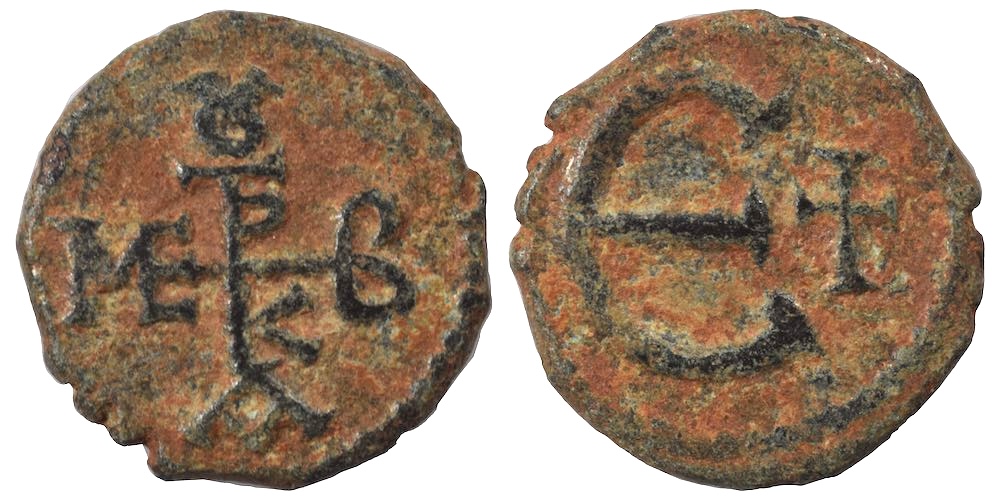 Maurice, 582-602. Maurice Tiberius
Maurice, 582-602. Maurice Tiberius
12.6 mm. 1.35 grams.
This monogram includes many letters: M, A, E, P, T, I, B, K, ɣ, and possibly V.
Monogram 17 in Sear.
Sear 542
MIBEC 105, page 162, only one cited. Dated "c. 591-602"
Sear 541.
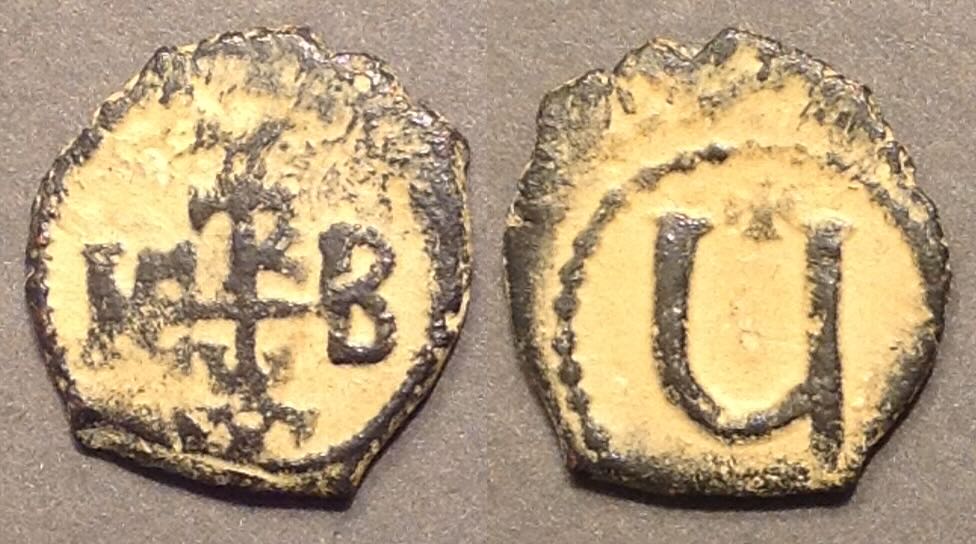 Maurice, 582-602. Maurice Tiberius
15.4-14 mm. 1.59 grams.
Maurice, 582-602. Maurice Tiberius
15.4-14 mm. 1.59 grams.
Sear monogram 60.
Again, there are many letters that can be found in the monogram--possibly with the addition of ω.
This monograms differs from the one above by having its "K" above the crossbar rather than below, and by having what looks like an omega (ω) just above the "A" at the bottom of the cross.
Sear 541. Antioch.
MIBEC unlisted.
Sear unlisted. I assign it 542A
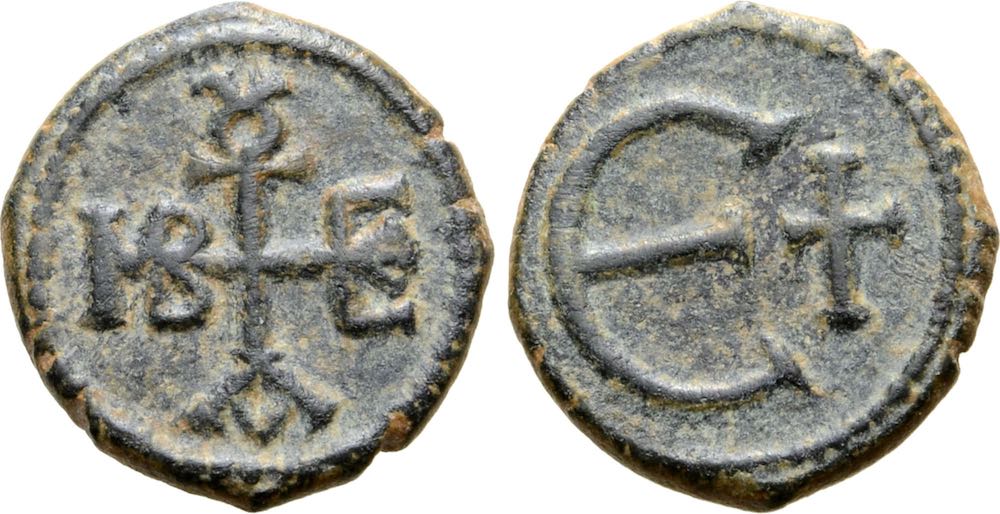 Maurice, 582-602. Maurice Tiberius
Maurice, 582-602. Maurice Tiberius
14-13 mm. 1.74 grams.
Є+ reverse.
ɣ, M, B, T, A, E, and possibly K and possibly I. The B could contain a P (rho).
MAOV TIBEPIOU
Not in Sear. Monogram not in Sear. It is closest to monogram 16.
Sear has 4 numbers assigned to pentanummia from Antioch, ending with 542. This one could be assigned 542A. Antioch mint.
Many types of Roman nummia of the fifth century have monograms, but there are few coins of the 1-nummis denomination after Anastasius (491-518) and very few of them monograms. However, there are 1-nummis pieces with monograms attributed to Justin II and to Maurice.
Sear 387
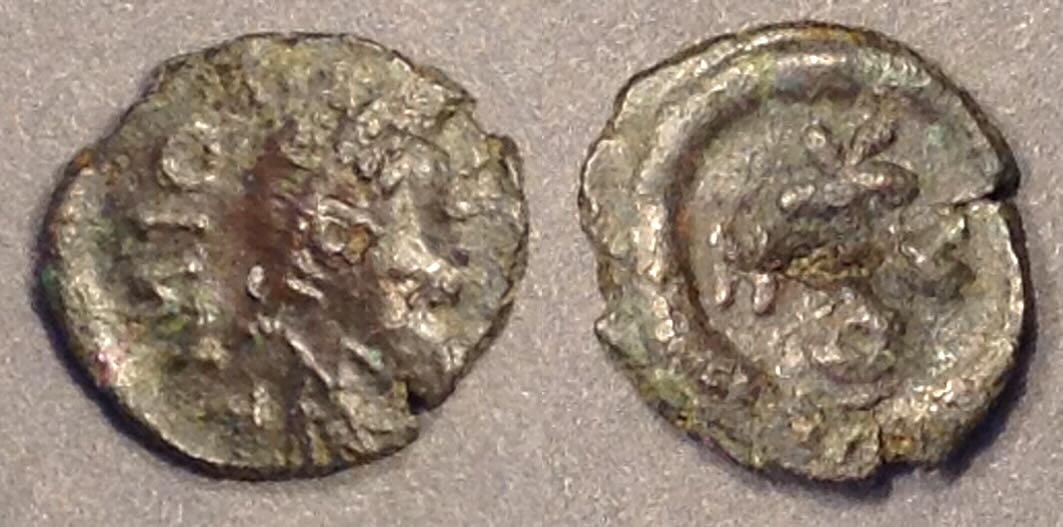 Justin II, 565-578
Justin II, 565-578
1-nummis piece.
10-9 mm. 0.73 grams.
Cross with N left and K(?) right, Y or V above and O below. Cross with horizontal stroke across the top forming a "T".
Rare. DOC 149 for Justin II. MIBE has it for Justin I, but Grierson gives it to Justin II.
Sear 387 (Justin II). Antioch. Monogram 11, but with crossbar below the V. I think the monogram is incrrectly drawn on Sear's page 32. It should have the crossbar that these examples show.
Sear 387, a second example.
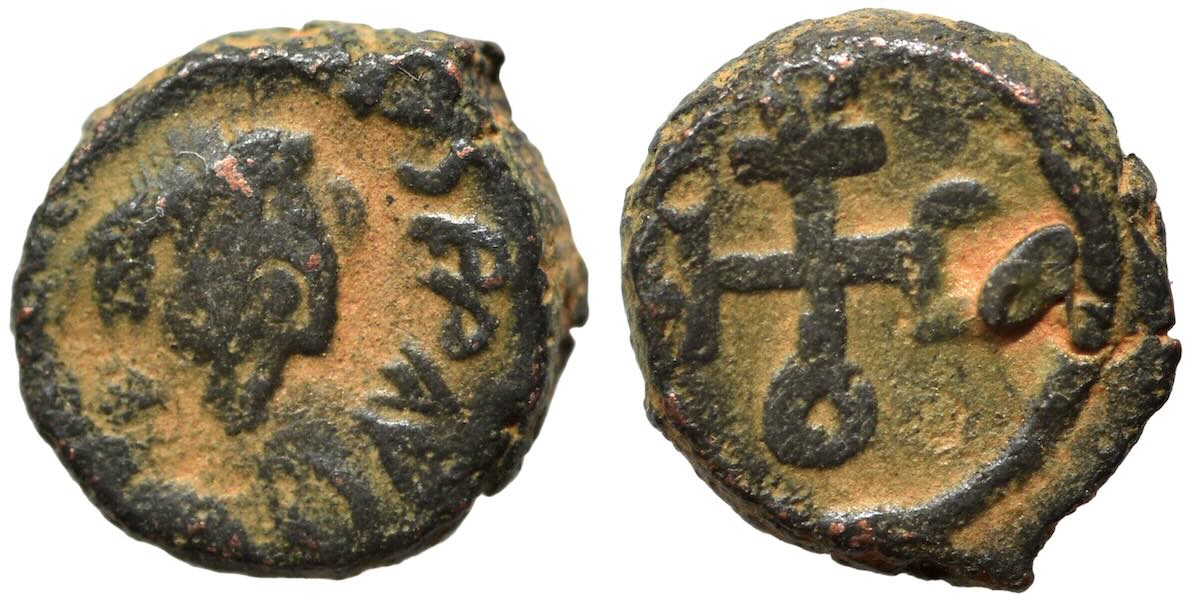 Justin II, 565-578
Justin II, 565-578
1-nummis piece.
9-8 mm. 1.06 grams.
As above, but smaller in diameter and thicker.
Sear 387, monogram 11, but with crossbar below the V. Antioch.
 Again, Sear 387, for Justin II
Again, Sear 387, for Justin II
1-nummis
8.5-8.0 mm. 0.61 grams. 7:00
Obverse legend, if any, not legible.
As above, but thinner. Well-centered.
Sear 387, monogram 11, but with crossbar below the V. Antioch.
A fourth nummis with a monogram is next.
Sear 572.
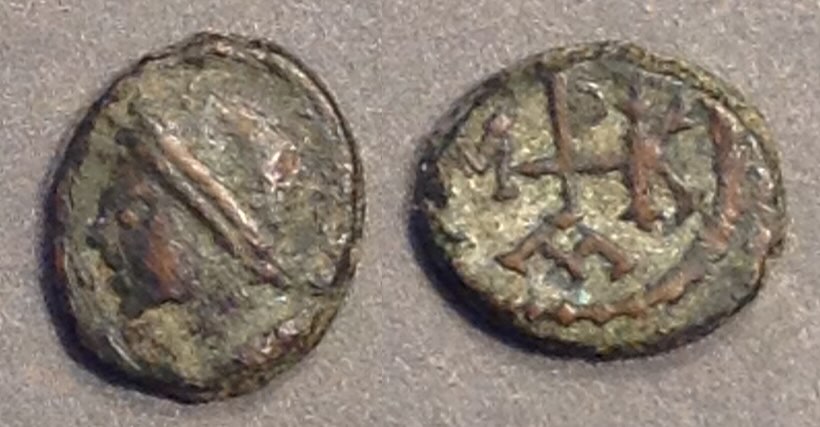 Maurice, 582-602
Maurice, 582-602
8.2-7.0 mm. 0.49 grams.
Bust left, diademed.
Cruciform monogram with
M, P, K, A, Y (almost off the flan at the top)
Monogram 19.
Sear 572 from Carthage. DOC --. BMC --. R --. BN I Maurice Carthage 7/Ct/AE/36-37. MIBEC Maurice 135.
Sear 676A.
 Phocas, 602-610. (Often spelled FOCAS on folles)
Phocas, 602-610. (Often spelled FOCAS on folles)
14.1-13.5 mm. 1.72 grams.
The cruciform monogram clearly has
ΦωKA (PHOCA, for Phocas)
Monogram 20 in Sear.
Є for 5.
Sear 676A. Antioch mint.
Sear unlisted. I assign it 676B.
Phocas, 602-610
15.5-14 mm. 1.10 grams.
The cruciform monogram clearly has
ΦωKA (PHOCA, for Phocas)
Monogram 20 in Sear.
Monogram as above, but u for 5
Not in Sear. The monogram with Є+ on the reverse is 676A (the previous coin). This one with u could be 676B. Antioch mint.
References:
Grierson, Philip. Byzantine Coins. 1982. Hardcover. It has 385 pages of text and 1527 coins well-illustrated in black-and-white on 95 page plates.
This is the best book for understanding Byzantine coinage, but it may be too deep for beginners. A prominent scholar gives the entire history of Byzantine coinage in one volume. It is not a book for beginning collectors, rather the latest scholarly word (as of 1982, but not yet superseded) on Byzantine coins. It is not a colorful and chatty book. Grierson is well-organized chronologically and attempts to be systematic and thorough. I consulted it very many times when writing my web pages on Byzantine coins. It is excellent. Highly recommended if you are serious about Byzantine coins. As I write Amazon has it used for $102 plus shipping.
Sear, David. Byzantine Coins and Their Values, second edition. 1987.
Abbreviated "Sear" on many sites. The primary collectors' handbook, with short histories of the emperors, a very nearly complete listing of Byzantine coin types, and many photographs, especially of the main types, but also even more types are not photographed. This is the book usually cited for identifying Byzantine coins. It is essential for collectors. Do not get the first edition. The second is far more complete, especially for late Byzantine coins.
It has short biographies on each emperor, and occasional one-line comments about types. It has a list of monograms (p. 32) and many of the inscrptions are translated (pp. 33-34). It is not a book to read, rather a book to consult. Many common types can be identified by comparison with Sear's photographs, but very many types are merely well-described. The first edition of Sear had little coverage of very late Byzantine coins. The second edition was greatly expanded and it much superior. As I write, the second edition is on vcoins at $45 and it is well worth it. Buy it!
If you want illustrations of the high percentage of the Byzantine coins you will encounter, Sear's book is not enough. Grierson's Byzantine Coins has 1527 coins illustrated--almost all the types you will encounter (see the second next review). The numerous (nine!) very large Dumbarton Oaks volumes have a nearly complete list and photographic coverage, often of several examples of any given type.
Using Sear. For each type Sear cites other major reference works which have examples and photographs. If a given work does not have it, a dash is used, e.g. DOC.-- means the type is not in the Dumbarton Oaks catalogs. This would be unusual because DOC is nearly complete and has good illustrations of almost every type. (If a type is unlisted, it is likely the DO collection has obtained an example since the paper catalog was published.) The citation "BMC 167" means coin 167 in the British Museum Catalogue is that type. (See my other, more detailed, page on Byzantine references.) Major catalogs and their abbreviations are on page 523. Pages 33-34 have many inscriptions translated. Page 31 has how to read explicit dates. Page 32 illustrates monograms. If you have the Sear number it will show you the monogram, but not the other way around. You can go from the monogram to the Sear ID number on a Forum page here. Sear was written before the final volume of Dumbarton Oaks was published, so late Byzantine types do not cite D.O. as a reference. Some cite Hendy ("H.") although I'm sure those citations would be replaced by D.O. citations if a new edition were to appear. (Most collectors do not emphasize coins that late anyway.)
An extensive web page on monograms, including the Sear monograms, on the Forum NumisWiki site:
https://www.forumancientcoins.com/numiswiki/view.asp?key=monogram
"MIBE" or "Hahn", formerly "MIB" = Moneta Imperii Byzantini, by Wolfgang Hahn (volumes 1 and 3) and Wolfgang Hahn and Michael Metlich (volume 2), in three volumes. MIBE = Money of the Incipient Byzantine Empire is the second edition, in English, of a work originally in German. Each volume is a fully illustrated list of all Byzantine coin types with some introductory commentary and pull-out charts with dates for the various issues. It includes in each listings the citations for one or more examples. (If only one is cited, the type is rare. If seven are cited, it is not.)
Volume 1, MIBE, covers Anastasius through Justinian I and includes 78 pages of introductory commentary in English.
[MIBEC] Volume 2, "MIBE, continued" covers Justin II through the revolt of the Heraclii with 72 pages of introductory commentary in English.
Volume 3 covers Heraclius through Leo III (in German, but you probably want the list with photographs. The few German words you will want to know to read the listings are pretty easy to figure out from the pictures. You won't get much out of the 208 pages of commentary in volume 3 unless you read German. Unfortunately, Hahn retired and it is unlikely that volume 3 will be revised and published in English, and it is unlikely the series will be continued chronologically to cover later emperors.)
Volumes 1 and 2 are now in English. The awkward name MIBE is, I think, an effort to keep the abbreviation in English similar to the previous abbreviation to capitalize on the name recognition it had accumulated. If you want a complete list and photographic coverage of Byzantine types up through Leo III (720 AD), this series of three works is for you, even though the third volume is only in German. Unfortunately, it is very expensive.
Whitting, P.D. Byzantine Coins. [An excellent and fun book for beginning with Byzantine coins, but it has almost nothing on the subject of this web page.]
 Monograms on Byzantine pentanummia
Monograms on Byzantine pentanummia Monograms on Byzantine pentanummia
Monograms on Byzantine pentanummia Theodosius II, 402-450.
Theodosius II, 402-450. Anastasius, 491-518
Anastasius, 491-518
 Justin II, 565-578, or Justinian, 527-565.
Justin II, 565-578, or Justinian, 527-565. Justin II and Sophia, 565-578
Justin II and Sophia, 565-578 Justin II and Sophia, 565-578
Justin II and Sophia, 565-578 ustin II, 565-578
ustin II, 565-578 Tiberius II, 582-602. Tiberius Constantine.
Tiberius II, 582-602. Tiberius Constantine. Tiberius II, 582-602
Tiberius II, 582-602 Maurice, 582-602, Maurice Tiberius
Maurice, 582-602, Maurice Tiberius Maurice, 582-602. Maurice Tiberius
Maurice, 582-602. Maurice Tiberius Maurice, 582-602. Maurice Tiberius
Maurice, 582-602. Maurice Tiberius Maurice, 582-602. Maurice Tiberius
Maurice, 582-602. Maurice Tiberius Maurice, 582-602. Maurice Tiberius
Maurice, 582-602. Maurice Tiberius Justin II, 565-578
Justin II, 565-578 Justin II, 565-578
Justin II, 565-578 Maurice, 582-602
Maurice, 582-602 Phocas, 602-610. (Often spelled FOCAS on folles)
Phocas, 602-610. (Often spelled FOCAS on folles)